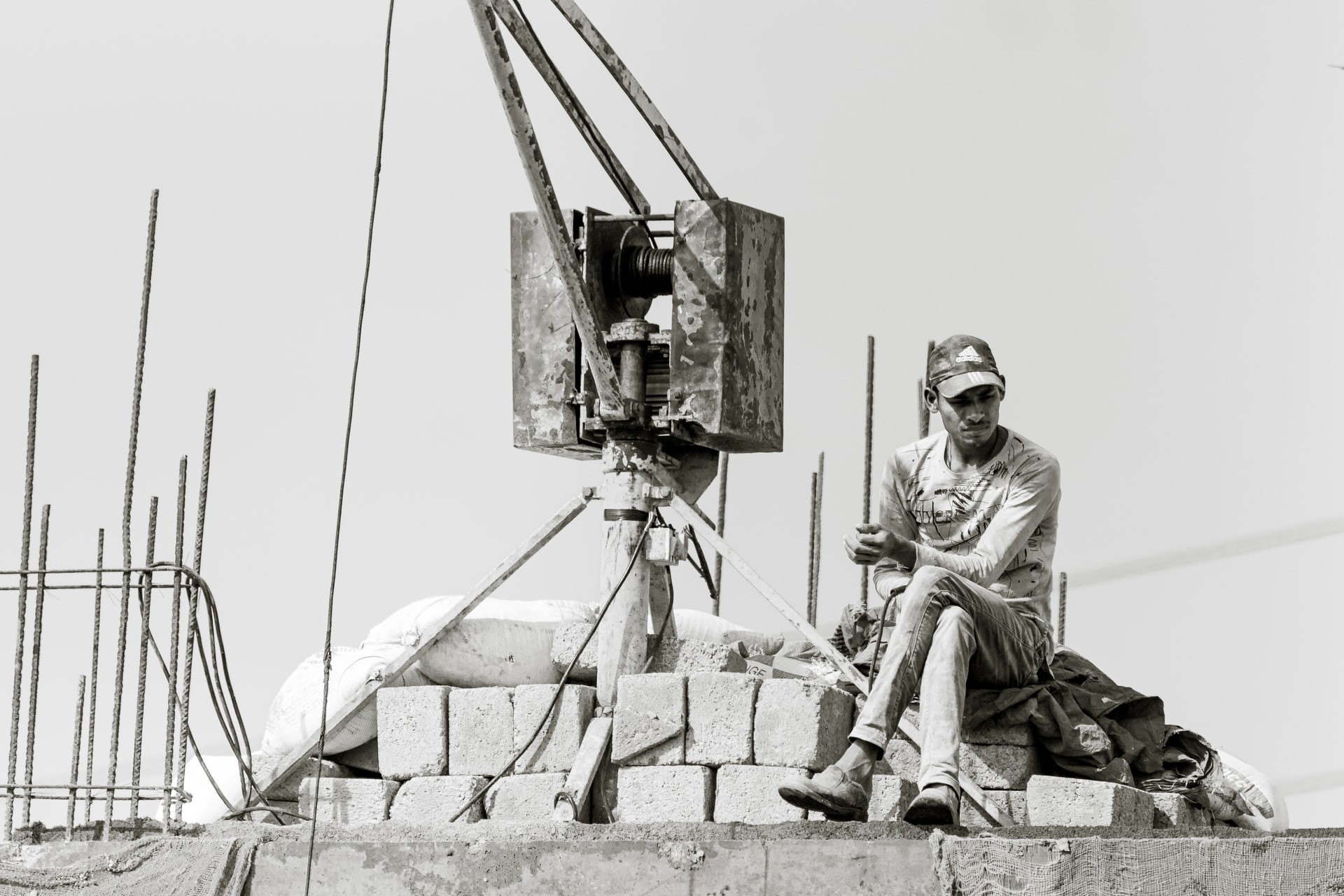India’s nationwide lockdown amidst the coronavirus pandemic has created a severe dislocation in the lives of its migrant population. Based on their research in Noida, a hotspot of the crisis, Ritanjan Das (University of Portsmouth) and Nilotpal Kumar (Azim Premji University, Bangalore) explain how the pandemic exacerbates the ‘chronic crisis’ in the everyday existence of migrants to unprecedented proportions.
In late March, as India stared at the outbreak of the coronavirus pandemic, Bijay Singh and six other men embarked on a 1,700 km journey from Chennai to their village in West Bengal. They were tribal migrant workers from Bhangidih, a village in the Purulia district, about 350 kilometres from state capital Kolkata. Upon reaching Bhangidih, they quarantined themselves outside the village perimeters. Fearing attacks from elephants, they tied cots with mosquito nets high up on mango and banyan trees, and would only come down for food that their family members left nearby. It took almost a week before the news reached the district administration that then made alternative arrangements.
India is currently in the third week of the 21-day nationwide lock-down amidst the pandemic. On the whole, the outbreak, albeit alarming, has not yet reached critical proportions. At the time of writing, the total number of cases is inching towards 5,000, with 124 reported deaths. Many reports, however, doubt these number, claiming that the test-rate in India is among the lowest in the world. There is fear that India could be weeks away from a major surge in cases which would overwhelm its crippling public health system.
However, despite the government’s announcement of a $22.6 billion stimulus package, the lockdown is a severe crisis for India’s migrant labourers. It is people like Singh, part of an estimated 453.6 million of India’s internal migrants, who are suffering from the worst. With their daily wages having dried up, most of them can barely afford rent or even food in the cities, and are thus left with little choice but to attempt a journey home by any means possible. In what is the greatest exodus since partition, this unprecedented flight of migrants from different parts of the country to their villages, especially from Delhi and the National Capital Region (NCR), has made international headlines. Stories from the ground signal the advent of desperate times. There are reports of workers stuck in informal settlements akin to detention camps, health officials using hosepipes to douse migrant labourers in disinfectant, and people attempting to walk hundreds of kilometres to reach home and even dying en route. As the plight of Singh and his fellow travellers shows, there is also fear and panic that those returning may spread the virus further, especially with authorities resorting to cramming people onto buses and into relief camps and homeless shelters.
Based on our ongoing ethnographic work in Noida – a city in NCR that has now become a hotspot of the pandemic – we propose some further thoughts about this mass exodus despite the government’s promises and instructions to stay at ‘home’.
Notions of ‘Home’ Amid the Pandemic
Delhi-NCR remains a major destination for north Indian migrants that form a sizeable group among the internal migrants in the country. Cities in the NCR like Noida have been receiving a high number of migrants over the last few decades, particularly from eastern Uttar Pradesh, Bihar and West Bengal, owing to a spate of industrial and construction activities. They work as street vendors, construction workers, security guards, housemaids, etc., living in rented accommodation in the urban villages of the city. Local villagers derive a significant income from these rentals. In most villages, a landlord has dozens of identical rooms for rent, set in rows on floors in narrow alleyways. Most house owners also run grocery shops from which tenants are expected to make their purchases.
Notwithstanding this, for the landlords, these migrant tenants remain the perennial ‘outsiders’ (baharwale), while they themselves are the ‘original inhabitants’ (mool vasis) of the area. They frequently complain that their villages have ‘become almost like slums’. Furthermore, over and above the difficulty of cohabiting in dense urban spaces, tenants are also seen as carrying the risk of cultural ‘contamination’. Due to their food practices, their poorvanchali and Bangla tongue, or for their supposed lack of personal hygiene, tenants are the social ‘others’ in the city. The migrants themselves take a dim view of their landlord’s exaggerated lifestyles as the ‘unearned privileges’ of an urban location.
We also found evidence that it is becoming increasingly harder for migrant workers to secure a margin of economic and spatial stability in Noida. The small scale manufacturing sector in the city has seen sharp casualization of employment since 1991. But the manufacturing and construction sectors were also severely hit by Demonetisation in 2016, which forced thousands of workers to shift to lower-wage service sector works. Barring those who have nothing left in villages to return to, most migrants are thus naturally compelled to still think of their villages as spaces of belonging and refuge during the present crisis.
Yet, it is also evident that going back to a rural home has never been more challenging than during the coronavirus lockdown. As several analysts have pointed out, forms of openness and flows have attracted unprecedented boundaries in rural India. Migrants will save up on rent if and when they reach home. They could also draw on ecological and social commons that some villages still have left outside of a market-price based system. Formal money and food transfers from the state will come handy provided that their coverage is broad. But it is unclear for how long these insufficient safety nets could sustain the migrants. Besides, with rural economy hurtling towards a contraction, the exodus will drag local wages down. The rush for ‘home’ could, ironically, produce an even more pronounced crisis at home.
On the Chronicity of Crisis as a ‘tradition’
Anthropologist Henrik Vigh observes that we commonly frame a ‘crisis’ as a rupture in isolation, fragmenting the coherence of our otherwise orderly lives. But drawing on ethnographies of conflict and crisis across African and Latin American societies, he suggests that there is often a ‘constant prospect’ of crisis woven into the social fabric in contemporary times. This anthropological approach of ‘crisis as context’ offers a productive lens to understand how migrant workers in Noida and other Indian cities respond to one crisis after another.
While the pandemic is undoubtedly creating an unprecedented livelihood dislocation, newer cities like Noida have been facing conflicting moral ethos and social crisis for decades. For long the migrants have confronted an anti-migrant attitude on one hand, and precarious employment opportunities on the other. The Covid-19 pandemic has further exacerbated and personalised this endemic context of crisis for the migrants. There is now an experience of radical limitation of one’s agency at one’s place of work as well as at one’s place of refuge, leading to experiences of truncation of horizons and opacity of futures and possibilities, but it is set amidst a context of chronic and persistent social crises.
The concept of ‘crisis as context’ also connects with Walter Benjamin’s rejoinder to traditional Marxism in his essay ‘The Concept of History’. Benjamin’s point is that the ‘present’ of the oppressed is never an ‘exception’ that is disconnected from his social past. Analogously, the current state of exception facing the migrant workers in India is barely an exception. Rather, it is temporally connected to – i.e., forming a ‘tradition’ of – multiple and ever deepening fractures of lived spaces, histories, and livelihoods in their everyday existence.
This article gives the views of the author, and not the position of the South Asia @ LSE blog, nor of the London School of Economics. Photo: Worker in Bangalore, India. Credit: Syed Ahmad, Unsplash.








Good article, you pointed out the real-life situation of Indian Migrant Workers. Another Part of the story is they all are not Indians. Many Bangladeshi’s are cross bordering without valid documents. Anyways migrant worker’s status is pathetic among all daily wages workers.